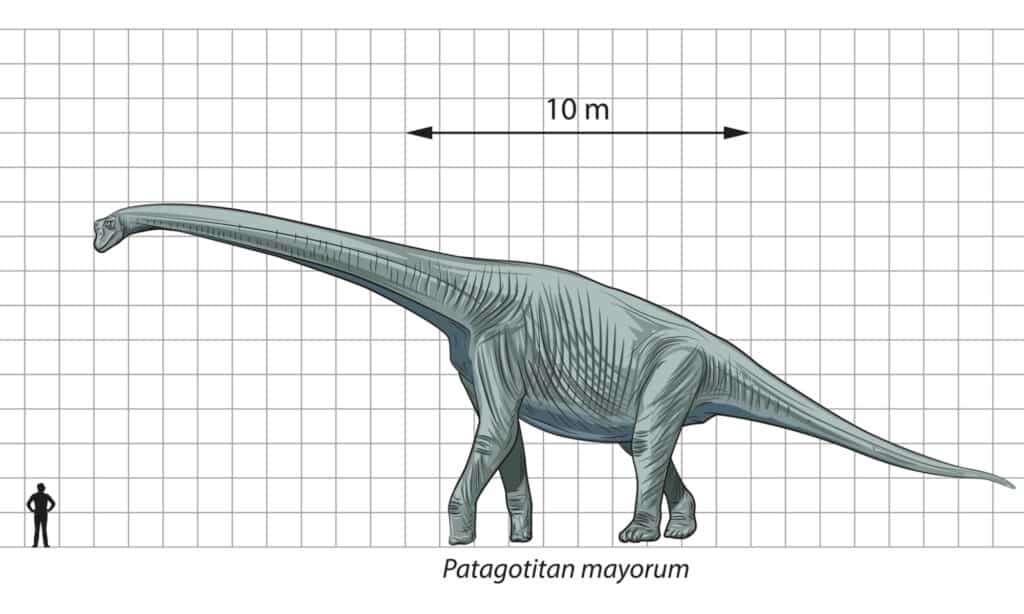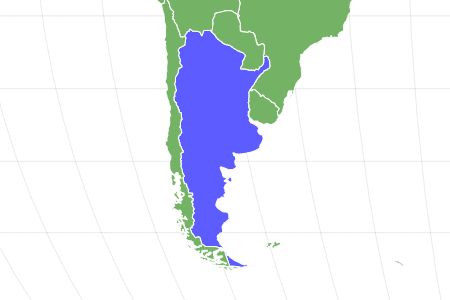Patagotitan
The patagotitan's bones were hollow and air-filled.
Advertisement
Patagotitan Scientific Classification
- Kingdom
- Animalia
Read our Complete Guide to Classification of Animals.
Patagotitan Conservation Status
Patagotitan Facts
- Fun Fact
- The patagotitan's bones were hollow and air-filled.
- Most Distinctive Feature
- It was one of the largest creatures ever to walk the earth!
- Distinctive Feature
- Massive size, hollow bones
- Diet
- Omnivore
- Favorite Food
- Leaves, fruit, tall grasses, flowers, and maybe small tree branches
- Type
- Dinosaur
- Nesting Location
- On the ground, covered by plant matter and dirt
View all of the Patagotitan images!
Patagotitan Description and Size
- Height (shoulder): 18 – 20 feet
- Height (head): Unknown, possibly 40 – 50 feet
- Weight: 65 to 75 tons
- Length: up to 122 feet
- Distinctive Features: Massive size, hollow bones
It was several years after the first patagotitan was discovered that it was given its official name so much of the information available refers to it as simply “the titanosaur,” though the name titanosaur officially refers to the whole group of long-necked sauropods to which patagotitans belonged. There is some debate over the exact size of the patagotitan, and whether or not it was larger or smaller than the argentinosaurus. However, all of the evidence seems to agree that the dinosaur was one of the largest creatures ever to walk the earth .
It is believed that the patagotitan was as long as 120 feet and as tall at the shoulder as 20 feet. Its head height is not known, but its neck made up around half its full body length, so if it could raise its neck straight above its shoulders, it could have reached as high as 80 feet. However, there is little known evidence to support patagotitan’s ability to do this and therefore it is likely the head would have only reached around 40 – 50 feet. Its bones were hollow and air-filled. They connected to the patagotitan’s lungs, allowing it to move easily in spite of its massive size. In illustrations, the upper portion of patagotitan’s body is shown to be disproportionately large compared to the size of its legs.
The scientific name for the Patagotitan is Patagotitan mayorum. It was named for: the area in which it was found, Patagonia; the owners of the ranch on which the first fossil was discovered, the Mayo family; and for the giant Greek gods known as the Titans.

Paleontologists believe that patagotitan’s head may have reached 40 to 50 feet high!
©EreborMountain/Shutterstock.com
Diet – What Did Patagotitan Eat?
The patagotitan was a herbivore. Little else is known about this titanosaurian sauropod dinosaur’s diet, though from its height, it can be surmised that the patagotitan likely enjoyed tree leaves, fruit, and perhaps even small branches. It may also have consumed tall grasses and flowers. Their evenly-spaced teeth were small and shaped like pegs.
Habitat – When and Where Patagotitan Lived
The patagotitan lived during the Albian age of the Cretaceous period, which was between around 113 million and 100 million years ago. All current evidence suggests that patagotitans were found exclusively in South America, specifically in Argentina in the Chubut Province of the Cerrino Formation. Though this area is now desert, it is believed that the habitat of the patagotitan was forests, which makes sense given its likely diet of tree leaves. This era was known to have an increase of flowering plants, and the area was suspected to be a warm floodplain, which suggests there was plenty of foliage to sustain even such a large creature as the patagotitan.
Patagotitan Threats And Predators
Like many other titanosaurs, it is likely that patagotitans were prey for a carnivorous species of dinosaur known as the abelisaurus, or “Abel’s Lizard.” The abelisaurus was alive and hunting in Argentina during the same period, so it is probable that it snacked on patagotitan from time to time, though their armor did not make them an easy meal. Because the eggs of the patagotitan were so small, that meant that there was actually another, more unlikely predator for their young. In India, the fossilized remains of a snake was found within a fossilized titanosaur nest, wrapped around three eggs, and appearing to have been eating a patagotitan hatchling at the time of its death.
Discoveries and Fossils – Where Patagotitan was Found
There are not many examples of patagotitan bones that have been found in comparison to some more recent species of ancient animals. This is because of the method by which the dinosaurs went extinct, specifically as a result of a massive meteor strike, versus more recent species of animals who lived during the ice age and froze to death. Also, the length of time since their extinction means many bones were simply lost to time and the elements. However, for a creature of its time period, six separate partial skeletal specimens are considered a lot, especially given that one example is more complete than most.
The first significantly intact patagotitan skeleton was partially unearthed in the form of an eight-foot thigh bone, by an Argentinian shepherd in 2012. However, proper excavation could not begin at the site until 2015. In addition to that skeleton, archaeologists have discovered bones from the neck, ribs, tail, shoulders, back, and front and hind legs of five other patagotitan skeletons. The first titanosaur bones were found in India in 1877, so the discovery of the patagotitan so many years later and across the globe was quite a surprise, especially given its vast size. Many of its individual bones are so large that they exceed the size of an adult human. It is estimated that patagotitans had more than 130 bones in their bodies. No patagotitan skulls have been recovered.
Estimated Lifespan, Group Behavior, and Reproduction of the Patagotitan
Though not enough specimens exist to form a clear picture of how long a patagotitan might have lived, scientists believe that their lifespan was probably somewhat similar to the argentinosaurus that lived in the same area, which was around 40 years. Likewise, not enough information is available to determine if they were solitary animals or grouping creatures. What is known is that patagotitans reproduced by laying relatively small eggs compared to their massive body size. It is believed that they might have laid as many as 10 eggs per clutch and that multiple clutches were laid per season. Eggs were laid in nests on the ground, which were then covered by plant matter and dirt. Baby patagotitans grew very quickly into adults and were unlikely to have received much in the way of parental care after hatching.
Extinction – When Did Patagotitan Die Out?
The last patagotitan appears to have lived on Earth just before the end of all the dinosaurs. It is believed that all the sauropods were wiped out, along with all other species that were extant at the time of the meteor strike, but it is currently unknown how the patagotitan specifically met its extinction as a species, since it is believed to have died about 100 million years ago and the meteor strike was only 66 million years ago.
Similar Animals to The Patagotitan
The dinosaurs most similar to the patagotitan are the other titanosaurs. These included:
- Dreadnoughtus – This dinosaur was about 85 feet from head to tail and weighed 65 tons. It lived in a similar region to patagotitan, but lived about 77 million years ago.
- Argentinosaurus – This dinosaur has been determined to be the patagotitan’s closest relative. It lived around 92 million years ago and some estimates show it as being even longer and heavier than the patagotitan.
- Saltasaurus – Though it also hails from Argentina, this dinosaur was significantly smaller than the patagotitan, coming in at a length of merely 40 feet or so. They weighed an estimated 7.5 tons, only around a tenth of the patagotitan.
Patagotitan FAQs (Frequently Asked Questions)
When did the patagotitan livee
The patagotitan roamed the earth around 100 million years ago, during the Cretaceous Period.
How Big was Patagotitan?
The patagotitan was between 18 – 20 feet tall, stretched over 120 feet long and may have weighed as much as 75 tons.
Where did the Patagotitan live?
Where did the Patagotitan live?
What did the Patagotitan eat?
The patagotitan was a herbivore who probably ate flowering plants and the leaves of trees from the forested area where they lived.
Thank you for reading! Have some feedback for us? Contact the AZ Animals editorial team.
Sources
- Science Alert, Available here: https://www.sciencealert.com/scientists-claim-they-may-have-found-the-largest-dinosaur-ever-known
- Prehistoric Wildlife, Available here: http://www.prehistoric-wildlife.com/species/p/patagotitan.html
- Wikpedia, Available here: https://en.wikipedia.org/wiki/Patagotitan
- Prehistoric Beast of the Week, Available here: http://prehistoricbeastoftheweek.blogspot.com/2017/08/patagotitan-beast-of-week.html
- New Scientist, Available here: https://www.newscientist.com/article/mg24632861-400-the-biggest-dinosaur-ever-may-have-been-twice-the-size-we-thought/
- Phys, Available here: https://phys.org/news/2021-01-gigantic-dinosaur-unearthed-argentina-largest.html
- Britannica, Available here: https://www.britannica.com/science/Albian-Stage
- Wikipedia, Available here: https://en.wikipedia.org/wiki/Cerro_Barcino_Formation
- American Museum of Natural History, Available here: https://www.amnh.org/exhibitions/permanent/orientation-center/the-titanosaur
- Scientific American, Available here: https://www.scientificamerican.com/article/snake-eating-dinosaur/
- Soft Schools, Available here: https://www.softschools.com/facts/dinosaurs/titanosaurus_facts/2292/
- Royal Society Publishing, Available here: https://royalsocietypublishing.org/doi/10.1098/rspb.2017.1219
- The Atlantic, Available here: https://www.theatlantic.com/science/archive/2017/08/is-this-really-the-biggest-dinosaur-ever-discovered/536187/

















